What is it that we know so well and cannot speak? What is
it that we want to say and cannot tell? What is it that keeps
swelling in our hearts its grand and solemn music, that is
aching in our throats, that is pulsing like a strange wild
grape through all the conduits of our blood….?
—Thomas Wolfe
_____________
It might as well have been a city on the moon, for all I knew of it growing up. And even after I was grown up. Countries in Europe were never even remotely on my radar screen, not in any real sense. Sure, I knew those countries existed, like Germany. And I read about Berlin, because of the Wall. But not Muenster. I might well have lived my whole life and never even heard of the place. And you don’t know what you don’t know, until you do.
And right at twenty years ago, I learned a little bit of what I didn’t know. It was sometime during my first year at Bob Jones University, that timid and self-conscious time when I was wearing my detestable straight-cut suit coat to classes, as any good plain Mennonite would. And now and then, while studying at the library, I searched for any books that would shed a little more light on my Anabaptist heritage. I don’t know what I was looking for. Some original writings, maybe. And to its credit, BJU had a few volumes tucked away on some remote shelves in the religion section. I picked them up and paged through them. Sat there and read chunks from different chapters.
All I ever knew about the Anabaptists, all I’d learned growing up, had come from two sources. From the sermons of Amish preachers, and from the Martyr’s Mirror. My spiritual forefathers were always a persecuted people, always harassed and hunted and tortured and drowned and burned at the stake for their faith. That’s all I had ever heard and that’s all I knew. Or thought I knew. Until I paged through those few books at the library at BJU. And it just jumped out at me. Some of those vaunted Anabaptist forefathers weren’t all they’d been cracked up to be, in those sermons. Nah. Some of them were real scoundrels. Radicals. Riff raff. And it was startling to me. It really was.
Because some of them had not been all that quiet or peaceable. Some of them had taken up the sword. Some of them had embraced violence, and inflicted blood and fire and death on others. I sat there, shocked. It’s like saying black is white, I thought. It can’t be. Anabaptists can’t be violent like that. They’re the ones everyone else hunted and killed. Both the evil Catholics and the Protestants. I’ll have to tell Dad about this. I wonder if he knows. I bet he does, and never told me. And I kept on reading. (Side note: The next time I went home to visit, I told Dad about my discovery. Did you know that, that some Anabaptists were crazy and violent? I asked him. He folded his arms and chuckled. “Har, har. Those weren’t real Anabaptists,” he said. Well, uh, yeah they were, I said. They were all re-baptizers. You can’t just pick and choose which ones were “real” or not. And we left it at that.)
The most brutal Anabaptist violence against others came down in the city of Muenster. There, a whacked-out firebrand of a leader named Jan von Leiden and his followers seized the city and proclaimed a new heaven on earth. Of course, the local king was not at all amused. Actually, he was quite furious. He besieged the city. But Jan and his followers weren’t about to give up their newfound heaven. They met force with force and violence with violence. Fire with fire and blood with blood. And they ruled the terrified inhabitants of Muenster with savage force as well.
It was a different time back then, obviously. And it’s tough, to grasp how it really was so long ago. Those were turbulent and dangerous days. You could easily lose your life, for thinking wrong. It was the struggle of the western world, to reach the place we now are. A place where you are free to think and believe what you want. Mostly, anyway. A post-Christian world, one might say, in Europe. Where most people recoil from any kind of personal profession of faith. A natural progression, maybe, a reaction to the cesspool of corruption that will always flow when people are taxed against their will to support any state-sponsored church. Any entity connected to the state will be corrupt from its inception. By nature. There’s no way it can be anything else, because the nature of the state is always corrupt and evil. But I digress. Bunny trail territory, right there.
The siege of Muenster dragged on for four brutal and bloody years, from 1533 to 1536. I won’t go into a lot of details. Let’s just say things got really hard and really messy inside those walls. Jan von Leiden ruled with an iron fist. Forced the city residents to either be re-baptized or face something a whole lot worse. Like being expelled from the city, turned over to the king’s murderous troops, lurking right outside the walls. Or stay and get murdered right in the city. There were no good choices for the common people trapped inside those walls. Food was scarce. And many of the men fell, either from starvation or during battles. Their widows needed husbands. So Jan took sixteen wives to himself. And lived in luxury, bedecked in gold and all kinds of finery, as the city starved around him.
Long-term, Jan could not win, of course. The king’s forces eventually broke through. The people inside Muenster were too weak and too starved to resist, after four years. And the king made an example of the leaders, so an uprising like that would never happen again. Jan and two of his henchmen were tortured to death in the public square. And this is where it all gets just a little creepy. After they had been dispatched by stabbing after having chunks of flesh torn from them with hot iron tongs, the king had the bodies of Jan and his two buddies stuffed into three cages. And hung them high on the steeple tower of the old church where Jan had ruled and preached and dictated the lives of others. Hung the cages up there on that steeple, and let the bodies decompose to the elements. As a warning to others. Don’t even try to rebel against the powers that be. Look what happens to those who did.
And that’s why I wanted to go to Muenster so badly. Because those cages still hang on that church today.
Thursday morning. I woke up feeling a little strange. And a little sad. It was all flying by so fast. The first week, more than half over now. And Leuphana University, the reason I had even been invited here, that was over, too. I’d leave today. Probably never see this place again, I thought. I puttered about, packing my things into Big Red and the little burgundy carry-on. The bags bulged at the seams. Heavier, now. People had given me gifts, here and there. A book. Another book. This and that. It all had to be packed in. After checking the room top to bottom to make sure nothing was left behind, I pulled my bags out and down to the front desk. The nice lady smiled at me. Well, she wasn’t actually that nice, but cordial enough. And she spoke a little English. I’m leaving, I told her. Is there anything I have to sign? “The University took care of everything,” she assured me. I thanked her and lugged the bags outside, into the little courtyard. Maryann and the taxi should be here right soon. At nine, she’d promised me.
We had plenty of time to catch our 9:30 train, Maryann had claimed. We had our tickets. It’s ten minutes, to the station. But I insisted on leaving early. Get there, so you’re there. It doesn’t hurt to wait. That’s what I do at airports, too. The few times I fly, I mean. Get there early, and just hang out. Wait, make it tight, and who knows what will happen? A little traffic jam will make you miss your flight. Or your train. The taxi showed up right on time, and we were off. I looked out the windows, got my last glimpses of Luenberg as the taxi cruised down the deserted streets. Ascension Day. A holiday. Not a lot going on. I looked around and thought, this town sure has been good to me. It really has. And now I’m leaving it. You absorb one thing as it comes at you, you walk through it. Then it’s gone and the next one comes.
I don’t know how efficient it actually is, what with the government running it and all, but the train systems I saw in Germany and later in Switzerland were pretty astounding. The coaches are roomy and comfortable. The trains run on time. And if you miss the one you wanted, another train will come along, usually before long. Our train hissed in and stopped. People piled off first, then on. Maryann found the right coach, and I followed her on board. We found our reserved seats in a little walled-off room, by the windows. I want to see the land, I had told her. And she got us window seats. I pretty much just looked out to see what I could see as the train slid out, picked up speed, and swooped across the ancient landscape. Muenster, I said. I can’t believe it. Here we come.
It’s built to last, pretty much everything you see in Germany. Their building codes would drive me crazy, I’m sure. So many hoops to jump through. These people don’t even know what a pole building is, I thought. Back home, the buildings I sell, those poles are warrantied not to rot in the ground for forty years. Forty years around here, they’ve barely started using the building. They’d never construct something so, uh, temporary. If you build something, make sure it has a good chance to last for a good long time. Generations. Hundreds of years, if not a thousand. Or more. Doesn’t matter, really, what it is. Houses, office complexes, old churches. And they all flashed by as we rolled on and on. Farmers toiled in the fields on their tractors, tilling the earth. Just like back home, I thought.
And something else stood out that I surely hope won’t be around in a thousand years, although the Germans probably built them to last that long. They stabbed into the sky like giant aliens, great forests of them, hundreds of feet high. One of the ugliest atrocities ever devised by humans. Giant windmills, with those huge three-pronged propeller blades that never seem to be turning when you see them. I couldn’t believe the Germans got taken by that scam. Those things are just flat-out appalling, I grumbled to Maryann. Why would they install something so revolting? Gashes in the sky, is what they are.
It’s the price of buying into the political correctness of the “Green” gospel, those massive, abominable windmills. All to get away from traditional forms of energy, to “save the earth”, this Garden of Eden that humans have defiled. And are in the process of destroying. Within a few generations, the time will come when people will look back, aghast, that such an obviously devious scheme was ever foisted on the populace. That such atrocities were ever allowed to mar the natural beauty of their ancient landscape. They will tear them down, people in the future, they will tear down those monuments to colossal stupidity as if they never stood. And they’ll shake their heads in disbelief at this hopelessly naïve generation. They will. That time will come. I am convinced of it.
The train pulsed along. Maryann and I talked and talked, even though I was peering out the window most of the time. She told me of how it was, to live in Germany, her adopted country. How she first came over, years ago, as a student. And pretty much stayed on. She talked of the classes she taught in American Studies, about writing in general, and my book. Now and then, the train slid into some station along the way and stopped. Passengers got on and off. And after one such stop, she told me. “Muenster is next. It’s coming right up.”
And it stirred inside me, the nervous tension and excitement. Here I was, approaching the site of some really dark history from my people. Here, this is where all that terrible stuff unfolded, evil stuff that was never told and never taught. I can’t express, really, why it was so important to me. But it was. I wanted to see the church. I wanted to see the cages. Stand there and look at them. Stand on the ground where the evil had come down from all sides. Confront it. Speak it.
The train slowed and stopped. We struggled out of the little compartment with our luggage. Walked out onto the platform and down the steps. A stranger in a strange land, I stayed close to Maryann as we plunged through the crowds and headed toward the station entrance. Outside, we approached the line of taxis, and boarded the first one. Maryann told the driver the name of our hotel, and off we went. Less than ten minutes later, we unloaded in front of a classic old hotel close to the old town section. We walked in, and signed in. I pulled out a roll of Euros and paid up front for our rooms. Might as well get rid of some of these Euros Sabrina gave me, I figured. I can’t spend them back home.
Half an hour later, after unpacking and settling in our rooms, we headed out. A beautiful perfect day. My trusty messenger bag was strapped across my shoulder, as always. With my passport, some cash and my iPad, to take some pics. And a copy of my book. I always carried one of those in my bag, just for anyhow. “The old church is right over there,” Maryann pointed to a steep Gothic steeple piercing the skies. “That’s where the cages are.” OK, I said. Let’s go. I can’t wait to see them. We walked down the worn brick sidewalks. All the stores were closed for Ascension Day. Crowds of holidayers strolled about. Down the sidewalks we walked, around a curve. The old church loomed. I scanned the steeple. No cages, from this direction, I said. “I think they’re on the other side,” Maryann replied. We walked on.
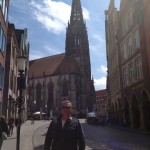
Approaching the “cage church”.
It was a huge, looming, gloomy church, with a tall, tall black steeple. We walked past the front, around to the courtyard on the other side. And Maryann stopped, and pointed up. “There they are,” she said. And I stood there and looked up. And there they were. The cages of Muenster. Right there, above the huge steeple clock. Hanging there, where they’ve hung for almost five hundred years. I stood there and looked and looked. Stared and stared. The cages. There are the cages. You don’t understand, I said to Maryann. This is part of my history they never told me. They never taught it. Anabaptists were always poor innocent people, in my world. Always persecuted because of their faith. Always hunted like animals. They never told me this story. They never told me of the dark side. That’s why it’s so important for me to see for myself.
I stood there on those ancient bricks in the sunlight and absorbed the place. For a long time. This, then, is where it happened, that dark chapter in the history of my spiritual forefathers. Back in those turbulent, turbulent times, back when people pretty much from every side had blood on their hands, one way or the other, in some form. This was the spot. Anabaptists. Rebaptizers. They rose up in this city, and they hung up there in those cages, I thought. Wiedertaufer, the Germans call them. It’s a dirty word, in mainstream church history. From both Catholics and Protestants.
And I thought, too. Because of what happened here, maybe that’s why the Martyr’s Mirror has so many stories of persecution and death. Because you can bet the powers that be went after the Wiedertaufer with full force, after what happened here. Didn’t matter if they claimed to be nonresistant, as in fact a great many if not the majority of them were. They were deeply tainted by Muenster. And I can understand why. Not from today’s perspectives. But from a tiny glimpse of the perspectives of the times. We can’t judge history that far back by our standards. We can say with absolute certainty that certain actions were wrong. But we can’t actually judge those people, not without taking into consideration the times in which they lived. Had we been there then, would we have been any different? It’s simply hubris, to claim we would have been.
The cages are completely empty. No shreds remain of the bodies that were encased in them. They have decomposed completely and scattered to the winds. Someone once told me that in the early to mid-1800s, some sun-bleached bones could still be seen in the cages. But time and the elements have claimed even those. Jan von Leiden and his two thug henchmen have been wiped completely from the face of the earth. Only the stories remain, of who they were and what they did. That, and the cages, silent specters, witnesses to the awful fate to which they were condemned.
After twenty minutes or so, we slipped through a little side entrance into the old church. The interior was just huge and breathtaking. Off in one corner stood an elderly nun, at a little information table. She was chatting with another tourist. We waited our turn respectfully. After the tourist wandered away, we approached. She smiled at us in welcome. Her name was Sister Huberta. Maryann spoke to her and the two of them rattled back and forth in German so fast that I hardly understood a word. “The cages,” Maryann told her. “This man is a descendant of the Wiedertaufer. He came to see the cages.”
“Oh, yes, the Wiedertaufer and the cages,” Sister Huberta was all smiles. Genuine smiles, too, considering where I came from. She opened a folder and showed me. Sketches of the evil Jan von Leiden and his two main henchmen. And she told us. “They ruled the city for four years, from 1533 to 1536. This church is where he preached and ruled. Things were not good. He beheaded one of his wives.” A fact I had read, and knew to be true. I chatted with Sister Huberta, through Maryann. Any chance I can get up in that tower and actually look at those cages close up? Her face fell a bit. “No, because of legal issues.” Maryann translated. That figures, I thought. Legal issues. I smiled at Sister Huberta. Then I asked. Would you take a picture with me? “Of course,” she told Maryann. “But not inside the church. I’ll walk outside with you.” Do you think she’d hold a copy of my book for the pic? I asked Maryann. I have one right here in my bag. So Maryann told her. “This man comes from the Amish and wrote a book about it. Would you hold it for the picture?” Of course she would, she beamed.

Jan von Leiden as depicted in Sister Huberta’s folder.
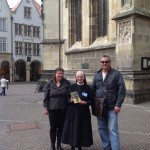
Maryann, Sister Huberta, and me.
Catholics are supposed to be all guilt-ridden, I know. Amish guilt is very close to Catholic guilt, and I’ve been there, done that. But Sister Huberta exuded mostly joy, not guilt. She was simply welcoming and joyful, even to a descendant of the despised Wiedertaufer. She chattered right along with Maryann, then smiled and wished us well and took her leave. Walked back to her post inside the church.
We strolled back into the church and looked around. The pulpit tower was still there, the spot where Jan had stood and preached. That, and the remnants of the bases of many statues of saints he and his rabid iconoclastic followers had smashed. Off to one corner stood a couple of tables with candles. A stack of unlit candles off to one side, by a little collection box. For a small donation, you could light your own candle, say your own prayer. I clinked a few Euros into the little collection box. Then Maryann and I both lit candles and stuck them on the tables with the others. I didn’t think to say a prayer, so I didn’t. My prayer was in my heart. And before the Lord, the heart speaks powerfully without words, whatever its condition, whether you want it to or not.
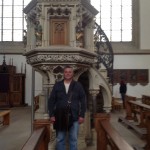
Jan von Leiden preached and ruled from this pulpit.
Our adventures with the cages weren’t quite done, though. We strolled on out to the courtyard toward the old shops lining the streets. And an elderly gentleman approached us. “You are from the Wiedertaufer?” he asked. I don’t know how he knew that. Maybe he’d been watching us, or maybe he had been inside the church and overheard our conversation with Sister Huberta. “Yes,” Maryann responded, motioning at me. “He is.”
“I live here in Muenster,” he said proudly. “Back in such and such a year (It was in the 1990s sometime), Muenster was voted the most beautiful city of its size in all the world.” He beamed. We beamed back. How nice. But he had something more to tell us. “Right here,” he said, pointing down to the bricks on which we stood. “Right here is the spot in the public square where they tortured and killed the three Wiedertaufer leaders, before they hung them up there in those cages.” I looked down. And there was a little plaque, inserted among the bricks. Marking the spot where the scaffold had stood. And again, I just stood there in awe, absorbing this moment and this place.
“You’ll want to go to the Museum,” the man said pointing. “It’s just over there, a few blocks. They have some displays of when it happened, there. With real things from that time in our city.” Maryann chatted with the nice man for a few more minutes, then he turned and strolled away, quite satisfied with himself. I looked at him as he walked away and marveled. He was the only person on the whole trip who popped out of nowhere to speak to me like that, then just disappeared. It was more startling in retrospect than it seemed right at the moment. Later, I thought about it. He was waiting for us. What chance was there that he would show up to show us this spot? And direct us? What chance was there of that?
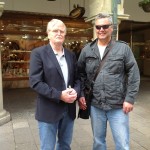
The stranger who showed up to guide us.
After a quick bite of pizza and a glass of beer in the courtyard right below the cages, we set off for the museum. There were a dozen or more rooms of displays. Numbers six and seven dealt with the Muenster Wiedertaufer rebellion and the cages. We walked through slowly, I drank in every display. The information signs were all in German. I pestered Maryann. Was sagt Das? Was sagt Das? What does this say? And she cheerfully translated for me. They had exact replicas of the three cages, hanging there. Odds and ends of this and that, including a set of torture tongs. The sign said these were likely the actual tongs used to tear chunks of flesh from Jan von Leiden and his two deputies. They hung there, on the wall. There were many other stern signs, too. In English and German. Do Not Touch. But I touched those tongs. And a few other forbidden items. I think Maryann was a little horrified at me. It didn’t matter. I was here. And I was going to experience this all the way.
By late afternoon, we returned to our hotel. My room was small but very nice. You could open up the window from the third floor and lean right out over the street. Where I come from, you could never do that. But right that moment, I couldn’t appreciate my surroundings much. I was just exhausted, physically and emotionally. After a brief nap, I met up with Maryann and we walked back out to find dinner. We stopped at a very nice little outdoor café. And afterward, we strolled through the lit streets and sidewalks of the old town, window shopping. The whole setting was just surreal.
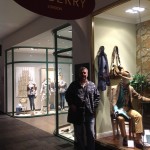
Night walk. Window shopping. Muenster. Duetschland.
The next morning, after a scrumptious breakfast in the hotel dining room (European hotels got breakfast down, big time), we took a last quick walk about the old town. Past the dark old church where the cages hung, a few blocks to another huge church. I shudder a bit to think where all the labor and materials came from, to build those huge old monuments of churches, centuries ago. Taxing the poor peasants to death, probably. That got the materials. And I don’t know, but I bet the laborers were pressed into service for the church, when they would have rather been out there working for themselves. I don’t know that. But I suspect it was so.
We walked into the massive old stone church. A huge statue stood there, toward the front, towering over everyone who walked in. “St. Christopher,” Maryann told me. “The patron saint of travelers.” Great, I said. This is an apt place to come, the morning I take off on my own for the first time. I felt the tension inside me from that. So far, someone had always been with me, to guide me, to take me, to show me. This morning, Maryann was heading back to Luenberg, back to her work and school. This morning, I was heading on over to Mainz, to speak at Johannes Gutenberg University that night. I could do it, travel alone. It was all set up. My hotel in Mainz was just across the street from the train station, they told me. Simple. Just walk out, look for the King Hotel, and go in. They’ll be expecting you. Still, I figured this little stop to see St. Christopher was a good thing. Can’t hurt, to cover all your bases. We each lit a candle in that church, as well.
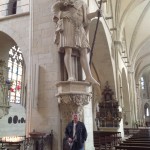
St. Christopher and the Christ child.
Back, then, to the hotel, to pack up to leave. And right on time, the taxi pulled up outside. We loaded our luggage, got in, and headed to the train station. I thanked Maryann over and over, profusely. Thanks for bringing me, for taking the time when you had a lot of other very important things that needed your attention. Thanks for realizing how important this was to me. And she gave me a hundred detailed instructions about trains, train schedules and such. We walked out to the platform. Our trains were departing minutes apart, going in opposite directions. Mine pulled in first. “Good luck. You’ll be OK,” Maryann assured me. We hugged good-bye. And I stepped onto the train for Mainz. All by myself.
A stranger in a strange land, I had seen and lived wondrous, wondrous things. And where I was going, there would be many, many more.
**********************************************
A couple of housekeeping notes. First, my last blog post was too long. I apologize for that. I wanted to cram in at least the first four days, the traveling and the Leuphana experience. It was too much to condense any more. And before I knew it, there were eleven pages of writing. Plus the pics. It was about as bad as an Amish preacher who doesn’t know when it’s time to shut up and sit down. Y’all come here to read a few pages on a blog, not a freakin’ chapter in a book.
And that’s why I broke this blog down to the single experience of Muenster. It would have been too much, to try to cram Mainz and its aftermath into this narrative. I figure there’s probably two more blogs about the trip. One for Mainz and beyond (still in Germany), and one for my week in Switzerland. I may wander off onto other trails before they all come out, but I’ll get them written eventually. Bear with me. And I promise. No more long-winded blogs.
I had planned to travel up to Aylmer to see my parents before my trip to Europe, but somehow it didn’t work out. So I told Dad I’d come up sometime in June. It’s looking like it might happen next weekend. I’m looking forward to seeing him. Just talking to him. I haven’t seen him since he’s read the book. And I want to print out and show him a few color photos of scenes from the trip. He’ll like that a lot, I think.
We’ll see how it all works out, and how the writing of it will come.
Share




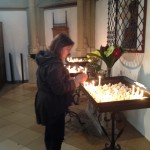
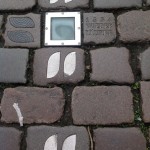
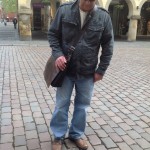
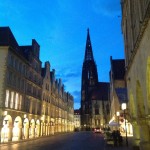
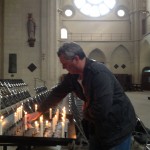
I love reading about your experiences in Europe. It’s been so long since I was there; I really miss it. I haven’t visited any of the Anabaptist sites yet, but it’s exciting getting a taste of the areas through your words. Thank you!
Comment by Amy — June 7, 2013 @ 7:19 pm
What an intriguing and fascinating post. I could have sat here and read it all night. It has left me wanting to read the rest of the story. I can’t wait for your additional posts on this wonderful journey of yours. Have a great visit with your dad. How great it will be for you to tell him of all you saw and did. Have a safe journey.
Comment by Rosanna — June 7, 2013 @ 7:45 pm
Very interesting blog! Really enjoy reading about the history of the area.
Marge
Comment by Marge nistler — June 7, 2013 @ 7:48 pm
Thank you again for painting a picture for those of us who might never see it otherwise. It seems there is always another side to the story we are told. I applaud you for searching it out and not only facing it, but embracing it.
Comment by Jenifer Woods — June 7, 2013 @ 8:23 pm
That was a fascinating story. Talk about skeletons in the closet. I related to your shock about the missing pages of history as I was also cornered by a bitter former Catholic and informed of the Catholic Church’s colorful past. It’s like a lawyer going to court to lessen his client’s sentence for stealing a television and after he makes his opening statement he finds out his client killed everybody in the store.
How does one speak to all that (and why would anybody want to?) At that social function, I might have said something wimpy like, “To each his own.”
Looking forward to the next installment.
Comment by Margaret — June 7, 2013 @ 8:37 pm
Our (Mennonite) school addressed this and many other unsavory topics about the early Anabaptists by having us spend a whole entire school year (I kid not) studying “Mennonites In Europe” for the year’s worth of history.
I am glad you blogged about this . . .
Comment by Welcome Home Katya — June 7, 2013 @ 9:12 pm
I found your story very fascinating and interesting because like you, I too thought the Anabaptists were always the persecuted ones never realizing that may not have been the whole story. I wonder why that information was not included in the Martyr’s Mirror?
Comment by Minerva DeJianne — June 7, 2013 @ 9:12 pm
What an interesting “read”!!!! It sounds like you had a great trip, and anxiously waiting for your next blog. We are so happy to know that you are going to see your dad, and do some “sharing” with him. Have a safe trip up here to Aylmer.
Barry and June, from Aylmer, Ont. Canada.
Comment by June Kinsey — June 7, 2013 @ 9:23 pm
I’m Amish-Mennonite (Beachy). I was always taught about Muenster growing up. I’m sorry you were not. As Beachys, we acknowledge an inheritance from the Amish of a tendency to sweep things under the carpet instead of talking about them openly. We’ve swung much more in the direction that facing things head on is much better (though we do still revert to rug sweeping at times). Once again, it makes me sad you didn’t learn about Muenster growing up. For us, we studied a lot of Anabaptist history growing up: the good, the bad, and the horrible. Muenster and other incidents served as stark warnings of how we should not go wrong.
I believe you’re wrong on this, however: “The next time I went home to visit, I told Dad about my discovery. Did you know that, that some Anabaptists were crazy and violent? I asked him. He folded his arms and chuckled. ‘Har, har. Those weren’t real Anabaptists,’ he said. Well, uh, yeah they were, I said. They were all re-baptizers. You can’t just pick and choose which ones were ‘real’ or not. And we left it at that.” While you’re right we can’t just pick and choose, that’s not what’s happening here. How would you react if I told you that I’m an anarchist who believes the government is a benevolent force for our own good? I think you’d be quick to point out that I’m not a real anarchist. When 90+% of Anabaptists’ main differentiating characteristic was non-resistance (yes, there were the seven articles of Schleitheim, but non-resistance was the most radical and prominent), it is intellectually honest and 100% correct to say that people calling themselves Anabaptists that did the exact opposite of that central tenet were not real Anabaptists. (And Schleitheim was seven years before Muenster.) Look at the widely accepted statements of faith. Crunch the numbers on adherents. To call Muensterites real Anabaptists is to deny reality. They were undoubtedly a very real offshoot of the Anabaptist movement and we need to ask ourselves hard questions about what weaknesses in our belief system allowed such monsters to form under our aegis, but they were definitely an offshoot that became the very opposite of what they started out as. Nonetheless, I feel shame at their actions.
Ironically in the same vein, while you’re a good guy unlike the Muensterites, I don’t think you’d try to call yourself an Anabaptist as you’re all about self-defense and gun rights and stuff–you know that goes against the central tenets of what Anabaptists have always believed.
—
“Wiedertaufer, the Germans call them. It’s a dirty word, in mainstream church history. From both Catholics and Protestants.”
It *was* a dirty word. In the past fifty years or so, several European denominations (Swiss-based Lutheran World Federation and the Swiss Reformed were leading ones) have reached out to Anabaptists to apologize for the persecution. In Switzerland a few years ago, there was a year proclaimed Year of the Anabaptist. The government gave a bunch of grants to make all the various Anabaptist landmarks nice and many, many Swiss visited those sites and learned the history.
(Dad does an Anabaptist history tour every year and I’ve been on it twice. Muenster is an essential part of it–a grim warning.)
But Anabaptist theology is actually quite fashionable in sectors of evangelical theology these days. Rick Warren’s a huge fan. A lot of guys like Greg Boyd, David Platt, Donald Miller, just to name a few are expressing very, very Anabaptist ideas these days. Here’s an article about Rick Warren.
—
Then, while on a retreat of prayer and fasting in the desert, he began to read the writings of the sixteenth-century Anabaptists.
“That encounter,” he told the gathering, “transformed my ministry. Almost everything we do at Saddleback we stole from the Anabaptists.”
“I’ve studied the Anabaptists all my life,” Warren said, “and I believe they were right. The roots of the global missions are not in the magisterial reformers; they are in the Radical Reformation.”
Warren went on to express deep appreciation for the Anabaptist influence on contemporary Baptist understandings of mission, discipleship, and ecclesiology.
In his welcome to the conference, Paige Patterson, president of the SWBTS and one of the architects of the conservative resurgence in the Southern Baptist Convention in the 1980s, echoed Warren’s words.
“Baptists are indebted more to the radical reformers than to the magisterial reformers,” he said.
http://www.themennonite.org/public_press_releases/Rick_Warren_praises_Anabaptist_thought
—
Here are a few interesting articles about the apologies:
http://spectator.org/archives/2010/10/04/mennonite-takeover
http://lancasteronline.com/article/local/12702_Anabaptists–Swiss-persecutors-will-make-amends—500-years-later.html
Comment by Hans Mast — June 7, 2013 @ 10:04 pm
That’s why I don’t blindly accept other people’s interpretation of scriptures, either. “Traditional” meanings are often lies to cover the sins of others.
Comment by Gorges Smythe — June 7, 2013 @ 10:16 pm
I loved reading this. I remember the amazement I felt when I entered a world where people didn’t even know who the Mennonites were. I grew up in a world where there were two kinds of people; Mennonites and non-Mennonites. Goodness, didn’t they know about our happy families, our jam and how we followed the whole Bible? Shocking really! I can imagine the feeling of being in a place where suddenly you were associated with “them crazies” after being raised as “the ones who are most pleasing to God because we keep the whole Bible.” Interesting!
Comment by Judith (Yoder) Young — June 7, 2013 @ 10:23 pm
It gave me chills as you approached the church, or maybe it was a subtle breeze from recent ancestors rolling over in their graves acknowledging our real inheritance. The virtuous, the violent, and the monstrous.
Comment by Monica — June 7, 2013 @ 11:16 pm
Reading about your trip has created a traveling itch! Someday… I will see Europe as well.:) And I for one, have to disagree with you about the last blog. I remember thinking…You can’t stop now!! I wanna know what happened in Muenster!! (when the writing is good and the subject matter fascinating, a blog can never be too long!!) Can’t wait to read the rest.
Safe travels.
Comment by Eileen — June 7, 2013 @ 11:18 pm
Read Ervin Schlabach’s dissertation “The Rule Of Christ Among Early Swiss Anabaptists”. I think you will find it well worth your time.
Comment by Joni Moser — June 7, 2013 @ 11:30 pm
Two points I want to comment on. Growing up GC Mennonite I had never heard of the rebellion either, however, now when I think on it there had to be some rebels in there somewhere. I know that sounds crass and what they did was wrong, just as the people that persecuted the Anabaptists were wrong, but when you truly study history many times it isn’t all nice and neat like people want us to believe. That is because as you said, they are trying to judge people’s actions with our way of thinking and values and culture.
The other thing I want to comment on is I am from Oklahoma where we have lots of the windmills that generate electricity, because out here they turn most of the time. We tend to notice the wind mainly when it doesn’t blow. So the wind is being harvested for something useful instead of just blowing things down. In the Plains states windmills have been used for generations to pump water from wells. The people putting up the windmills are just using the same principal. One of the largest wind farms in Oklahoma is 5-10 miles from my house. Yes it changed the landscape, I don’t know if for the worse, just different.
Comment by Rosie S — June 7, 2013 @ 11:36 pm
Holy moly – what an adventure. And do not ever be concerned about writing too much – and make sure to keep telling details about hotels and meals etc. Hope I don’t dream about those cages tonight. Thank you so much, Ira.
Comment by Debra Vida — June 8, 2013 @ 12:16 am
Thank you Ira, for the big chapter, which was inspiring for me.
Comment by Lena Wickey — June 8, 2013 @ 6:09 am
Very interesting! I work at “Behalt”, the Amish & Mennonite Heritage Center, and not only is the Muenster Uprising depicted on the painting there rather prominently and in all its violence, we do talk about it to both Anabaptist visitors & tourists alike and I personally describe the whole event as being sparked by radicals or fanatics and point out there are usually fanatics to be found in any religious denomination.
I’d love to be able to take some of the trips you are taking. Some day???
Comment by Mark Oliver — June 8, 2013 @ 9:16 am
Hello Ira.
I love your “reads” and they are NEVER too long, but are so interesting I don’t realize how long it takes me to read them. I enjoy you painting a picture with words, so wonderful. I think I will do some research on the Anabaptists, sounds very interesting.
Thanks again and so glad you got to go on this trip.
Linda
Comment by Linda Morris — June 8, 2013 @ 4:16 pm
Very thought provoking. I am also descended from Anabapists. I know nothing of that history. I have seen the old churches in France but enjoy your writings and descriptions. Keep on writing about your adventures and don’t worry about the length.
Comment by Linda Ault — June 8, 2013 @ 5:19 pm
Not surprised at noting how the label ‘Anabaptist’ is defended by claiming “We are not the same as them.” In order to avoid the stain that comes with such bad behavior, we claim they are not real Anabaptists.
It is also apparent with Sam Mullet and his capers. I have spoken to Amish that say he isn’t really Amish. In order to protect our neat and tidy image of what we are, we simply try to remove the other person’s label. The behavior is noted in the Bible where Jesus speaks to the law teachers and Pharisees. The reply is in Matthew 23: 30, “If we had lived in the days of those who lived before us, we wouldn’t have done what they did.” Sad to say, history isn’t always kind to us.
Comment by Eli Stutzman — June 8, 2013 @ 9:13 pm
Ira, I’m not much of a reader, but I enjoy reading your writings. Thank You, Warren
Comment by Warren — June 8, 2013 @ 9:49 pm
It must be fantastic to rest ones feet on soil of a distant land. I went to New Foundland on a hunting trip with friends once, and was totally aware that I was in another country and was a little giddy about it. I really didn’t appreciate the trip until I got home with both feet planted firmly on familiar ground. I barely slept the entire time I was there. I hope you had a few calm times to soak in all the atmosphere of Germany.
Comment by Paul M Wins — June 9, 2013 @ 8:30 pm
Ira, you’re a fantastic writer. I don’t just mean the way you paint the picture and help us feel, but the perspectives you take that make us rethink and think a little deeper. And I don’t mind telling you I’m offended that you’d give any creedance to “saints” – but I can tell you why when I get home (having seen how that operates here among animists).
Hey, what I wanted to say is that a GREAT book analyzing Anabaptists – from the original dissenters under Augustine, who basically ruled the Constantinian State-Church once, is ANATOMY OF A HYBRID by Leonard Verduin. He looks at it philosophically. It’s subtitles “A Study in Church-State Relations” and he sees the State (even enforced uniformity in smaller communities) as always a beast, and the true religion of Christ as that which resists that conformity by Standing for Truth. Not just a good book about Anabaptism, but I’d rank it one of my top 100 books, period.
At the risk of being too long, I’ll quote the beginning of his postscript chapter: “In this study we have examined the actions and interactions of two religious traditions. On the one hand is the pre-Christian tradition, which needs unanimity and thus enforces conformity; on the other hand stands authentic Christianity, which needs diversity and therefore feeds the idea of the composite society. Basic to the difference between the two is a divergent view of [humankind]. In authentic Christianity, with its Corpus Christi view of the church, [a human] is seen as a being who, since he exists ‘in God’s image,’ has a sort of sovereignty: God deals with him in a way decidedly different from the way he deals with the rest of his creatures. In this view, God does not deal with [humankind] ‘as with sticks and stones’ – to borrow an expression authentic Christianity has devised for the purpose – but as a person.”
I’d be surprised if you haven’t read it, but if so, it is well worth your time. It hardly needs pointed out how closely we see, then, that the religious spirit (false prophet) is aligned with the political spirit (beast), and thus how religion and a State can both operate in coercion that diminishes God-given personality; “the manifestation of the Spirit for the common good.”
Comment by LeRoy — June 9, 2013 @ 11:46 pm
Fascinating story. All the sects of Christendom have skeletons in the closet (or in cages).
Comment by cynthia r chase — June 10, 2013 @ 8:56 am
Thank you for sharing your impressions with us. For me it’s always very interesting what visitors notice in my country.
But where does the Catholic guilt thing come from? It is found almost exclusively in English literature, but what is the origin of that?
At least here Protestants accuse Catholics that they are much too baroque and make a fun fair out of everything. An accusation that I can not really refute, because the German word for fun fair is an abbreviation for Church consecration and like carnival only celebrated in Catholic regions. Oh, and no, we were not taxed to death for our cathedrals. The construction of cathedrals was always a community project and was funded by donations.
Okay, if we donate – we still do – for a cathedral, monastery or church, we can assume that the church prays for us. However, this is not such a great incentive for donors, because without donations they pray for us, too.
Perhaps that explains why the construction of cathedrals often went over centuries. It’s just not much in it for the donor. Again, I wonder where this assumption comes from. I mean, you do not go past a town hall, a bank building or a shopping mall and ask yourself how many citizens were taxed or exploited for these buildings, right?
Comment by Sabine — June 10, 2013 @ 12:40 pm
Oh heavens above! These pictures! The “cage church” at night is absolutely spectacular. The brilliant blue sapphire sky blanketing the black jagged steeple which reeks of death. The gray-yellow that slowly transforms into pure welcoming white light as the eye works its way down.
Reminds me of the human dilemma, this photo. There’s God in His glory covering the earth (sky), then the angst of human kind exhaling all sorts of wickedness (steeple). The gray-yellow then yellow-gray representing the one who receives Christ into his heart and is slowly changing by the grace of God (building). And lastly, or should I say the next beginning, the shedding of all evil and the comforting, holy, secure, embrace of the Father of Lights (lighted doorways and windows). A beautiful photo, Ira.
Sigh. I’m still jealous. But grateful that you’re sharing such descriptive detail. And, above all, I’m happy for you that you had, and will continue to have, this grand experience. By the way, the seasoned gentleman that shared and chatted with you was obviously an answered prayer.
It amazes me how ancient these structures are yet how well preserved. And, oh, the unseen centuries old stories brushing the garments of those walking their haunted halls. Another sigh.
So, Ira, when are you going to realize you’re doing US the favor of writing, not we doing you the favor of reading? Be truly humble friend and thank God that He has blessed you so richly with the gift of writing both long and short stories. I’m surprised you don’t charge us. Have a wonderful trip visiting with your folks.
Comment by Francine — June 10, 2013 @ 12:53 pm
Thanks, Ira, for writing. I had similar feelings when I visited the place in 2005, though I had heard the story as a kid. An amazing, sobering, and stunning experience.
We were told the skeletons were taken down in World War II because they were afraid the church might get bombed by planes and the skeletons would end up on the street. So to avoid that they took them down.
Comment by Brandon Mullet — June 11, 2013 @ 5:20 pm
A prison in Philadelphia built for punishment…but men have worshipped there. A church in Muenster built for worship…but men were punished there.
You’ve taken us into some remarkable edifices this year. Iron, Stone, and Wax.
The cages, cells, and candles residing within our hearts and relationships.
But the wax turns out to be stronger than the iron or the stone. As long as we choose to light the candle instead of grasping the tongs.
I also like to leave way early just in case. An hour or so of waiting around upfront is so much better than going through the aggravation and cost of missing the boat.
Comment by Eric — June 13, 2013 @ 8:25 am
Great post Ira! In Mennonite school I learned all about my Anabaptist heritage–the same version you were taught. It shocked me when, about 12 years ago, I read in the book of Menno Simons’ writings, that he allowed divorce and remarriage. (Have that page in the big fat book flipped over in a dog ear. Not so that I can promote divorce and remarriage, but to remember the inconsistency of religious history, and to worship nothing and no one but God.) The things you write about here, I didn’t know of or hear of until sometime in the last two years. It was jolting, to say the least, and I had a hard time grasping it. (Helps me make a bit more sense of the fact that we still carry shocking secrets in our culture.)
I enjoyed this blog very much! The one line stuck in my heart and head is: “My prayer was in my heart. And before the Lord, the heart speaks powerfully without words, whatever its condition, whether you want it to or not.” Beautiful!
Comment by Trudy Metzger — June 19, 2013 @ 7:05 am